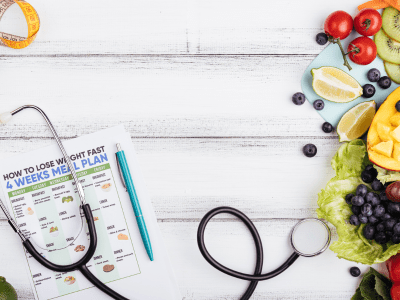Prediabetes Diet: Meal Plan, What Foods to Eat and Avoid

-
Posted by
 Prachi Shah
Prachi Shah
INTRODUCTION
Prediabetes is a serious health condition where blood sugar levels are higher than normal, but not high enough yet to be diagnosed as type 2 diabetes. Of those with prediabetes, more than 80% don’t know they have it. Prediabetes puts you at increased risk of developing type 2 diabetes, heart disease, and stroke.
WHAT EXACTLY IS PRE-DIABETES?
You have prediabetes if your:
- Hemoglobin a1c is between 5.7-6.4%
- Fasting Blood Glucose is between 100-125 mg/dL
- Oral Glucose Tolerance Test 2 hours after eating reads between 140-199 mg/dL
These statistics typically measure insulin resistance, which means that your body is not using insulin properly. Insulin is a hormone released by the pancreas in response to glucose. Think of insulin as a key and your cells as a lock. In someone who does not have insulin resistance, insulin unlocks the cells so that glucose exits your blood stream and enters the cells for energy.
In someone with insulin resistance, it’s as if the cells have changed the locks. Insulin can no longer interact with cells and be used as energy. Instead, the glucose remains in the blood stream, causing your blood sugar to remain high. As a result, these blood sugar levels appear on your lab tests.
WHAT ARE THE CAUSES OF PREDIABETES
Insulin is a hormone made by your pancreas that acts like a key to let blood sugar into cells for use as energy. If you have prediabetes, the cells in your body don’t respond normally to insulin. Your pancreas makes more insulin to try to get cells to respond. Eventually your pancreas can’t keep up, and your blood sugar rises, setting the stage for prediabetes—and type 2 diabetes down the road.
WHAT ARE THE SIGNS AND SYMPTONS?
You can have prediabetes for years but have no clear symptoms, so it often goes undetected until serious health problems such as type 2 diabetes show up. Some risk factors include:
- Being overweight
- Being 45 years or older
- Having a parent, brother, or sister with type 2 diabetes
- Being physically active less than 3 times a week
- Ever having gestational diabetes (diabetes during pregnancy) or giving birth to a baby who weighed more than 9 pounds
- Having polycystic ovary syndrome
Prediabetes Meal Planning: A Balanced Approach
Creating a well-rounded prediabetes meal plan involves balancing macronutrients, monitoring portion sizes, and incorporating a variety of nutrient-dense foods. Best dietitian in Vadodara shows how to structure a prediabetes-friendly diet:
- Focus on Whole Foods: Emphasize whole, unprocessed foods such as fruits, vegetables, whole grains, lean proteins, and healthy fats. These foods provide essential nutrients and fiber, promoting satiety and helping to control blood sugar levels.
- Carbohydrate Management: While carbohydrates are a crucial energy source, it’s essential to choose complex carbohydrates over simple sugars. Opt for whole grains like brown rice, quinoa, and whole wheat, and limit the intake of refined grains and sugary snacks.
- Lean Proteins: Include lean protein sources like poultry, fish, tofu, paneer, dals and legumes, in your meals. Protein helps stabilize blood sugar levels and promotes a feeling of fullness.
- Healthy Fats: Incorporate sources of healthy fats such as avocados, nuts, seeds, and olive oil. These fats contribute to heart health and can aid in better blood sugar control.
- Portion Control: Pay attention to portion sizes to prevent overeating. Using smaller plates and being mindful of serving sizes can help regulate calorie intake and maintain a healthy weight
These specific foods that can be beneficial for individuals with prediabetes:
Healthy diet for pre diabetics includes:
- Eat more veggies: Plant-based fiber fills you up without raising blood sugar. Vegetables are also full of nutrients. Aim for at least 3-5 servings a day. Fill half your plate with colorful, nonstarchy vegetables. Examples include carrots, bell peppers, broccoli, and leafy greens like spinach or kale.
- Cut back on starchy vegetables: Starchy vegetables include white potatoes, sweet potatoes, corn, and winter squash like acorn or butternut. These have more carbohydrates than their nonstarchy counterparts. But they have healthy nutrients, too. If you use the plate method, give them a quarter of the space.
- Snack on fruits: These plant-based sweets have sugar, but that doesn’t mean you should avoid them. Fruit is packed with fiber, vitamins, and minerals. Aim for two to three servings a day. That could be one small apple or ½ cup of strawberries. Best fruits for pre diabetes can include berries, kiwi, and oranges. Try pairing your fruit with healthy proteins like natural nut butter, Greek yogurt, or almonds.
- Choose whole grains: Unlike refined grains, whole grains have all their original fiber and other nutrients. You can eat them for breakfast or as a side dish for lunch or dinner. They come in lots of forms, including oatmeal, brown rice, whole-wheat bread or pasta, and quinoa.
- Add more nuts and seeds: Grab a handful of any kind you like. Just make sure they’re unsalted. And stick to the serving size, about a tablespoon. Nuts and seeds have healthy fats, but they’re also high in calories. Good choices include walnuts, pistachios, peanuts, sunflower seeds, and cashews.
- Add some protein: Try including protein with all your meals and snacks. It helps you feel full and slows how fast carbohydrates go into your bloodstream. That’s important when it comes to keeping your blood sugar steady. Sources include fatty fish and seafood, plant-based protein like beans and lentils, eggs, paneer, tofu and lean meats.
- Functional foods: Adding functional foods to your diet like fenugreek seeds and cinnamon can help in managing blood sugar levels. The fenugreek seeds contain fiber and other chemicals like trigonelline that may slow digestion and the body’s absorption of carbohydrates and sugar. The seeds may also help improve how the body uses sugar and increases the amount of insulin released.
Cinnamon may help lower blood sugar and fight diabetes by imitating the effects of insulin and increasing the movement of sugar from the bloodstream into cells. It can also help lower blood sugar levels by increasing insulin sensitivity, making insulin more efficient at moving sugar into cells
Foods to Avoid in a Prediabetes Diet
Equally important as incorporating beneficial foods is avoiding those that can negatively impact blood sugar levels. Best dietician in Vadodara suggests some foods to limit or avoid in a prediabetes diet:
- Sugary Beverages: Cut back on sugary drinks such as sodas, energy drinks, and fruit juices. These can cause rapid spikes in blood sugar levels.
- Processed Foods: Minimize the consumption of processed foods, which often contain hidden sugars, unhealthy fats, and excessive sodium. Opt for whole, unprocessed foods whenever possible.
- Sweets and Desserts: Limit the intake of sweets, candies, and desserts. These foods are typically high in refined sugars and can lead to rapid blood sugar fluctuations.
- White Bread and Refined Grains: Reduce the consumption of white bread and other refined grains. These can cause a quick rise in blood sugar levels.
- Highly Processed Snacks: Snack on whole foods like fruits, vegetables, and nuts instead of highly processed snacks like chips, cookies, and crackers.
Low carbohydrate diet for pre diabetes:
A low-carb diet can help people with diabetes better manage their blood sugar levels.
Carbohydrates or carbs raise blood glucose more than other foods, meaning the body must produce more insulin to digest them.
Reducing carb intake can help stabilize blood glucose. It may also counteract some other effects of diabetes, such as weight gain and heart disease.
Despite this, low-carb diets also carry some risks, including vitamin and mineral deficiencies. For some people, low-carb diets are challenging to stick to over time.
A very low-carb diet includes just 30 grams (g) or less per day. Low-carb diets include 130 g or fewer of carbs, while moderate-carb diets include between 130 and 225 g of carbs.
Another strategy — which may be more sustainable — is to slowly and steadily reduce carb intake and see how blood glucose levels change.
Foods to eat and avoid:
Most of the calories in a low-carb diet should come from healthful, natural sources, including: vegetables, lean protein, such as eggs, fish, nuts, and tofu, good fats, such as olives or avocado, fruit in moderation
As part of a low-carb diet, people should avoid or limit intake of the following: processed foods, such as prepackaged meals and salty snacks, sugar-rich foods, such as cakes, candies, pastries, cookies, sodas, and juices, starches, especially white bread or bagels, alcoholic beverages, potatoes, including potato chips, other starchy vegetables, white pasta, cereals and its products
Why Exercise is Beneficial for Those With Prediabetes
Of course, pre diabetes diet is important but exercise also play a major role in managing blood sugar levels. That’s because exercise does more than improve fitness. Whether it’s aerobic exercise or strength training, regular physical activity benefits the liver, pancreas, skeletal muscle, cholesterol levels, blood sugar levels, aids in weight loss, and beyond. Plus, the body is more sensitive to insulin (which is a positive thing for stable blood sugar levels) for up to 96 hours, or 4 days, after exercise.
In addition, exercise can (although doesn’t always) lead to weight loss, which can help reduce risk as being overweight is one common factor linked to type 2 diabetes.
The best exercise for prediabetes includes both aerobic and strength training:
- 150 minutes of moderate-intensity cardio or 75 minutes per week of vigorous aerobic activity, plus
- 2 or more days of moderate-intensity resistance training
Pre diabetic diet meal plan:
- Breakfast: High protein breakfast options like any cheela, any pulse chaat, eggs, dhokla, yogurt + berries
- Mid morning snack: Carrot/cucumber sticks with hummus
- Lunch: Gluten free millet rotis + sabzi + dal/pulse with a side of salad
- Evening snack: A cup of roasted chana or plain popcorn or a fruit with nuts
- Dinner: Indian options like khichdi, dal + rice, mix veg paratha, egg wraps or grilled chicken with veggies or marinated paneer or stir fry
